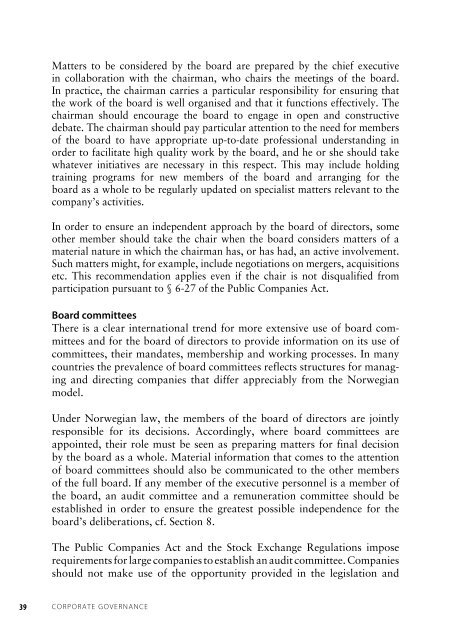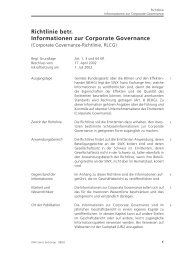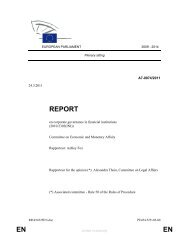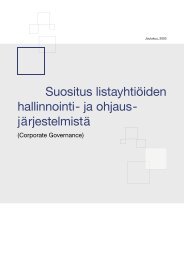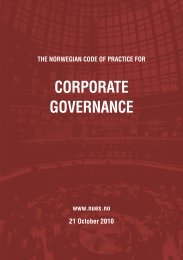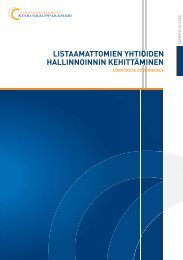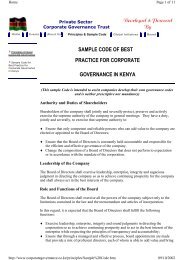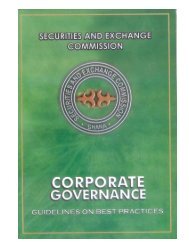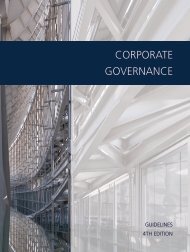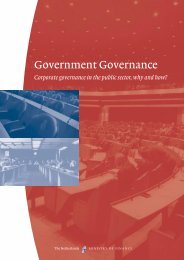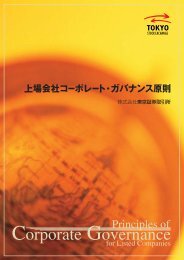The Norwegian Code of Practice for Corporate Governance - Statoil
The Norwegian Code of Practice for Corporate Governance - Statoil
The Norwegian Code of Practice for Corporate Governance - Statoil
You also want an ePaper? Increase the reach of your titles
YUMPU automatically turns print PDFs into web optimized ePapers that Google loves.
Matters to be considered by the board are prepared by the chief executivein collaboration with the chairman, who chairs the meetings <strong>of</strong> the board.In practice, the chairman carries a particular responsibility <strong>for</strong> ensuring thatthe work <strong>of</strong> the board is well organised and that it functions effectively. <strong>The</strong>chairman should encourage the board to engage in open and constructivedebate. <strong>The</strong> chairman should pay particular attention to the need <strong>for</strong> members<strong>of</strong> the board to have appropriate up-to-date pr<strong>of</strong>essional understanding inorder to facilitate high quality work by the board, and he or she should takewhatever initiatives are necessary in this respect. This may include holdingtraining programs <strong>for</strong> new members <strong>of</strong> the board and arranging <strong>for</strong> theboard as a whole to be regularly updated on specialist matters relevant to thecompany’s activities.In order to ensure an independent approach by the board <strong>of</strong> directors, someother member should take the chair when the board considers matters <strong>of</strong> amaterial nature in which the chairman has, or has had, an active involvement.Such matters might, <strong>for</strong> example, include negotiations on mergers, acquisitionsetc. This recommendation applies even if the chair is not disqualified fromparticipation pursuant to § 6-27 <strong>of</strong> the Public Companies Act.Board committees<strong>The</strong>re is a clear international trend <strong>for</strong> more extensive use <strong>of</strong> board committeesand <strong>for</strong> the board <strong>of</strong> directors to provide in<strong>for</strong>mation on its use <strong>of</strong>committees, their mandates, membership and working processes. In manycountries the prevalence <strong>of</strong> board committees reflects structures <strong>for</strong> managingand directing companies that differ appreciably from the <strong>Norwegian</strong>model.Under <strong>Norwegian</strong> law, the members <strong>of</strong> the board <strong>of</strong> directors are jointlyresponsible <strong>for</strong> its decisions. Accordingly, where board committees areappointed, their role must be seen as preparing matters <strong>for</strong> final decisionby the board as a whole. Material in<strong>for</strong>mation that comes to the attention<strong>of</strong> board committees should also be communicated to the other members<strong>of</strong> the full board. If any member <strong>of</strong> the executive personnel is a member <strong>of</strong>the board, an audit committee and a remuneration committee should beestablished in order to ensure the greatest possible independence <strong>for</strong> theboard’s deliberations, cf. Section 8.<strong>The</strong> Public Companies Act and the Stock Exchange Regulations imposerequirements <strong>for</strong> large companies to establish an audit committee. Companiesshould not make use <strong>of</strong> the opportunity provided in the legislation and39 CORPORATE GOVERNANCE


